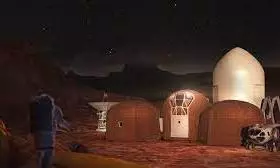
Mars habitat on Earth: NASA unveils 3D-printed houses for experiments
text_fieldsWashington: NASA is giving a peek into Martian houses and has unveiled a 3D-printed house. The set-up is designed for experiments related to future Mars expeditions.
It has four small rooms, a gym, and red sand. The 1,700-square-foot (160-square-metre) home is called Mars Dune Alpha. It also has two bathrooms, a vertical farm to grow vegetables, a room dedicated to medical care, an area for relaxing, and several workstations. It is located at the research base in Texas.
The house is also attached to an outdoor reconstruction of the Martian environment. Residents will have to go through an airlock to get there. A weather station, a brick-making machine, and a small greenhouse are also part of the hangar.
The space agency said that the house was created to mimic the Martian climate. Volunteers who are not astronauts will live and experience the simulation habitat in the next few months. Three planned experiments titled the Crew Health and Performance Exploration Analogue (CHAPEA) will be taking place here. Four volunteers will begin the first experiment this summer and NASA will monitor their physical and mental health to understand humans' fortitude for long isolation and use of resources.
Grace Douglas, lead researcher on the CHAPEA experiments, said: "We can really start to understand how we're supporting them with what we're providing them, and that's going to be really important information for making those critical resource decisions. Such a distant mission comes with very strict mass limitations."
A treadmill suspended from straps will be stimulating Mars' lesser gravity. Volunteers will be using the treadmill to simulate long trips outside to collect samples, gather data, and build infrastructure. Suzanne Bell, head of NASA's Behavioural Health and Performance Laboratory, jokingly said the goal is not to have them just walking around in circles for six hours.























